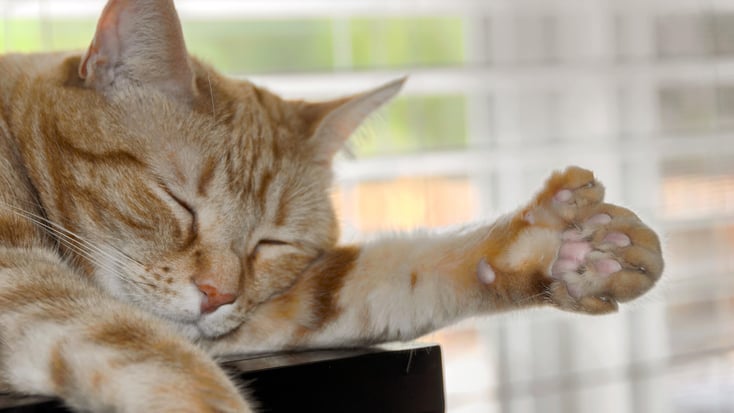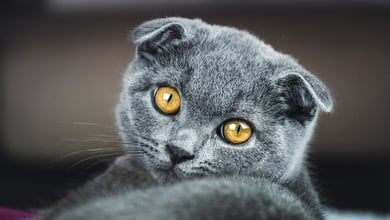Polydactyl Cat: Facts & Personality Traits

Table of Contents
Polydactyl cats have an extraordinary genetic trait that sets them apart - they are born with extra toes! This condition, known as polydactyly, gives these cats additional digits on their paws. They are often referred to by playful names such as 'big-foot cats', 'cats with thumbs', 'six-toed cats', or 'mitten kittens', highlighting their unique and fascinating characteristic.
The term "polydactyl" itself derives from the Greek words "poly," meaning many, and "daktylos," meaning digits. This intriguing condition predominantly affects the front paws of these feline friends, although their hind paws can also be involved.
Read on to discover fascinating facts about their unique anatomy, personality traits, and the captivating stories surrounding these special cats.
Key Takeaways:
- Polydactyl cats have extra toes, a condition called polydactyly, which is a harmless genetic trait.
- The extra toes primarily appear on the front paws but can also be found on the hind paws.
- Polydactyl cats can be found in various breeds, have diverse personalities, and enjoy good health with proper care. Regular nail trimming is important to prevent overgrowth and potential injury.
History and Origins of Polydactyl Cats
Polydactyl cats have a rich history and fascinating origins. They gained popularity among sailors during the age of exploration and were believed to bring good luck on sea voyages.
Ernest Hemingway, a renowned author, was particularly fond of polydactyl cats, and his former home in Key West, Florida, now serves as a museum and sanctuary for these unique felines, known as "Hemingway cats."
Today, polydactyl cats can be found in various cat breeds, such as Maine Coons, American Shorthairs, and domestic shorthairs, adding to their charm and allure.
Physical Characteristics of Polydactyl Cats
Typically, cats have four digits on each hind paw and five digits on each front paw, including a non-weight-bearing dewclaw that can be likened to a non-functional thumb.
However, polydactyl cats exhibit one or more additional digits on their paws. These extra toes can display various characteristics, such as being fully formed with an additional bony digit, nail, and paw pad, or an enlarged dewclaw resembling a thumb. It is important to note that the extra digits in polydactyl cats predominantly appear on their front paws, although in some cases, they can also be found on the hind paws.
In addition to the extra toes, polydactyl cats can exhibit variations in size, body shape, and coat characteristics, just like any other cat. The specific breed and individual genetics of the cat determine these variations. Polydactyly primarily affects the paws' structure, but it does not necessarily influence other physical attributes.
Polydactyly is a harmless genetic trait found in polydactyl cats that has no adverse effects on their health or overall well-being. This unique condition, characterized by the presence of extra toes, is not a cause for concern and does not pose any health risks.
Breeds Known for Polydactyl Traits
Several cat breeds are known for commonly having polydactyl individuals. The Maine Coon, with its friendly demeanor and tufted ears, often displays extra toes on its front paws. American Shorthairs, known for their sturdy build and affectionate nature, can also exhibit polydactyl traits on both front and hind paws. Additionally, polydactyly can be found in domestic shorthairs, encompassing a diverse range of cats with varied coat patterns.
It's worth mentioning that polydactyly can affect both genders of all breeds, and it's interesting to note that polydactyl cat parents can have litters consisting of both normal kittens and polydactyl kittens. The inheritance of this fascinating trait adds an element of surprise and wonder to each new litter.
Personality and Temperament of Polydactyl Cats
In terms of personality, polydactyl cats are as diverse as their paw configurations. While no specific personality traits are directly linked to polydactyly, individual cats may exhibit a range of temperaments and tendencies.
Some polydactyl cats are known to be outgoing, friendly, and sociable, often enjoying the company of humans and other animals. Others may be more independent and reserved, preferring solitary activities and a quieter environment.
It's important to remember that each polydactyl cat is unique, and various factors, including genetics, early socialization, and individual experiences, can influence their personality. As with any cat, spending time with a polydactyl companion and understanding their individual needs and preferences will help foster a strong and rewarding bond.
Common Health Issues Associated with Polydactyl Cats
Polydactyl cats generally enjoy good health, and their extra toes are not considered a handicap or health concern. However, it's important to note that their nails require special attention. Considerations such as excessive nail growth apply to both normal dew claws and any additional claws.
Since these claws are non-weight-bearing, they don't naturally grind down, which can lead to overgrowth. Without regular trimming, the nails may curl around into the paw, potentially causing injury.
Seeking guidance from a veterinarian or professional groomer experienced with polydactyl cats can provide helpful techniques for maintaining their nails. Additionally, checking the paw pads for any complications related to the extra toes is important. By proactively addressing their nail care needs, you can prevent discomfort, injury, and complications associated with overgrown nails.
Routine veterinary care is essential for polydactyl cats like any other cat. Regular checkups, vaccinations, and preventive measures are necessary for their overall well-being. This regular care allows for early detection and management of any potential health issues unrelated to their polydactyly.
Life Expectancy of Polydactyl Cats
The life expectancy of polydactyl cats is generally similar to that of non-polydactyl cats. On average, domestic cats have a lifespan of 13 to 17 years, although some may live well into their late teens or early twenties with proper care.
Several factors can influence the life expectancy of polydactyl cats, as with any other cat. Genetics, overall health, diet, exercise, living environment, and access to veterinary care all play significant roles. Providing a balanced and nutritious diet, regular exercise, a safe and stimulating environment, and timely veterinary checkups and preventive care are crucial for promoting the longevity and well-being of polydactyl cats.
It's important to note that while polydactyl cats have unique paws, their life expectancy is not directly affected by their polydactyly. As long as they receive proper care and attention, polydactyl cats can live fulfilling and healthy lives comparable to other cats.
If any specific health concerns or issues arise, it is recommended to consult with a veterinarian for appropriate guidance and care tailored to the individual cat's needs.
Final Thoughts
In conclusion, with their captivating extra toes, polydactyl cats live vibrant and fulfilling lives without any inherent health concerns. Their unique paws only enhance their charm and individuality, making them truly special companions. Whether you're already a fan of these "big-foot cats" or fascinated by their unusual paws, embracing and caring for polydactyl cats is a rewarding experience.
Frequently Asked Questions
How much is a polydactyl cat worth?
Polydactyly can occur in cats of various breeds, so the availability and pricing of polydactyl kittens can vary. It is recommended to conduct thorough research and consult with reputable breeders or adoption centers to find a polydactyl kitten within your desired price range and preferred breed.
Are polydactyl cats inbred?
No, polydactyl cats are not inherently inbred. Polydactyly can occur naturally in cat populations without specific breeding practices.
Are polydactyl cats rare?
Polydactyl cats are not considered extremely rare but are relatively uncommon in the general cat population.
How common are polydactyl cats?
The prevalence of polydactyl cats can vary, with certain breeds, like the Maine Coon, having a higher incidence of approximately 40-50% of individuals exhibiting extra toes.







